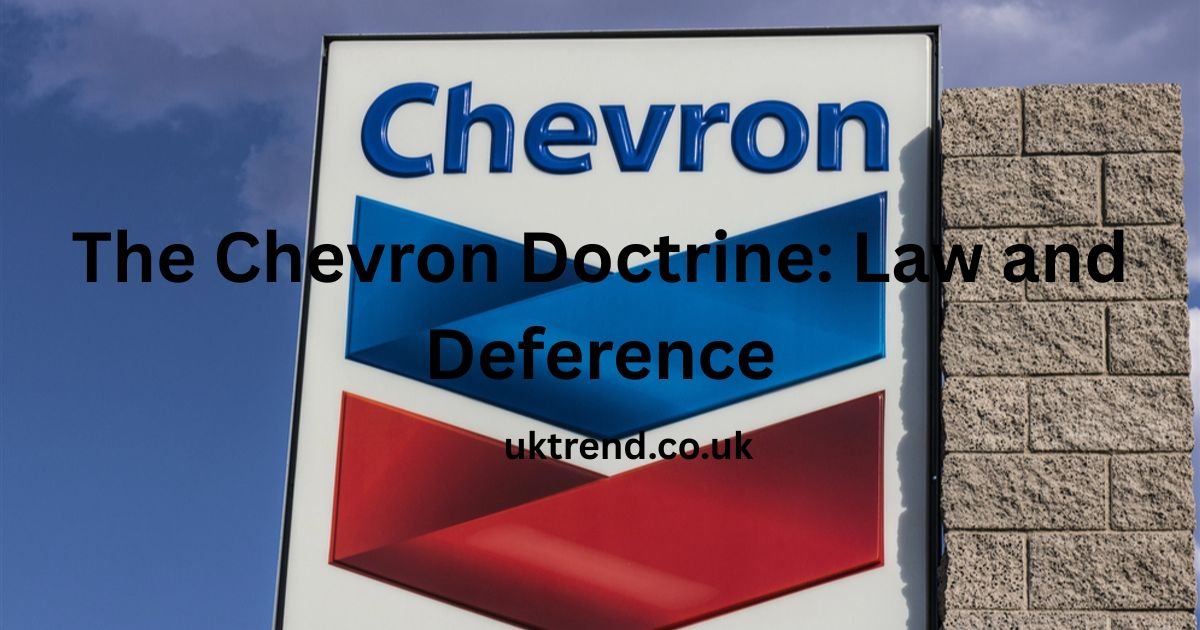Introduction
Administrative law provides the legal backbone for how government agencies function, allowing them to create rules, enforce laws, and settle disputes in specialized fields such as healthcare, the environment, and finance. Central to this system is the Chevron Doctrine, which guides courts to defer to an agency’s interpretation of a statute when the law is unclear and the agency’s interpretation is reasonable. This principle ensures agencies like the EPA and FDA can apply their expertise effectively while maintaining legal consistency. Without administrative law and doctrines like Chevron, regulatory clarity and efficiency would be difficult to achieve.
Related Article: Chevron Doctrine for Dummies: A Beginners Guide
A Brief History of Chevron v. NRDC
The landmark case emerged from a legal battle over environmental regulations and agency authority. Sparked by differing views on how the EPA should interpret the Clean Air Act, the case reached the Supreme Court, where its outcome would redefine judicial review in administrative law.
The Case that Shaped Administrative Law
In the 1980s, the U.S. faced a case that would forever change the relationship between courts and administrative agencies. This case, Chevron U.S.A., Inc. v. Natural Resources Defense Council, Inc., set the foundation for what’s known as the “Chevron Doctrine”—a principle that governs when courts should defer to agency interpretations of law.
At its core, the case revolved around the interpretation of the Clean Air Act. The question was whether the EPA had the authority to interpret the law in a way that allowed it to regulate certain pollutants in a manner that wasn’t explicitly stated in the statute. The Court’s decision essentially paved the way for agencies to have more leeway in interpreting ambiguous statutes, as long as their interpretations were reasonable.
Understanding the Legal and Political Context of the Case
The case came at a time when the U.S. was grappling with how much power federal agencies should have in regulating complex issues. Politically, there was a tug-of-war between those advocating for stronger federal regulation (like environmentalists) and those pushing for more limited government interference (like business interests). The Supreme Court’s ruling in Chevron shifted the balance, giving agencies more discretion to interpret laws, which would have significant implications for future cases.
The Chevron Doctrine: What It Means for Judicial Review
The Chevron Doctrine significantly shifted how courts interact with administrative agencies by emphasizing judicial restraint. It established a framework where judges step back and allow agencies to interpret laws, as long as those interpretations are reasonable under ambiguous statutes.
Breaking Down the Doctrine and Its Core Principles
So, what exactly is the Chevron Doctrine? Simply put, it’s the idea that when a law is unclear or ambiguous, courts should defer to an agency’s reasonable interpretation of that law. There are two main steps involved:
- Step 1: Is the statute clear? If it is, then the court applies the plain meaning of the law.
- Step 2: If the statute is ambiguous, then the court will defer to the agency’s interpretation, as long as it’s reasonable.
This doctrine prioritizes agency expertise, recognizing that specialized agencies are often better equipped to make decisions about complex regulatory issues.
Why Chevron Matters in Modern Administrative Law
Chevron matters because it emphasizes the need for agencies to have flexibility when it comes to interpreting and implementing laws. In a rapidly changing world, many laws are not always crystal clear. The Chevron Doctrine allows agencies to step in and provide clarity, ensuring that rules are updated and applied correctly without constant intervention from the courts.
Step 1: Is the Statute Clear or Ambiguous?
In the first step of Chevron, courts assess whether the statute’s language is clear. If the law is unambiguous, the court applies its plain meaning. However, if the text is unclear or open to multiple interpretations, the case moves to the second step, where deference to agency interpretation may come into play.
The Role of Statutory Interpretation
The first step in applying Chevron is determining whether the statute is clear on its face. Courts look at the text of the law and try to interpret its plain meaning. If the language is straightforward, then the court’s job is easy: they apply the law as written. However, if there’s ambiguity—meaning the law doesn’t provide clear guidance—then the case moves to the next step.
How Courts Evaluate the Clarity of Statutes
Judges look at various factors when deciding whether a statute is clear. They consider the plain language, the intent of the lawmakers, and the overall context in which the law was passed. Sometimes, courts may rely on legislative history or previous interpretations to help clarify what the law means.
Step 2: Reviewing Agency Interpretation
If a statute is ambiguous, courts then evaluate whether the agency’s interpretation is reasonable. Given their expertise in specific fields, agencies often base their interpretations on technical data and industry knowledge, and the court’s focus is on ensuring that the interpretation aligns with the law’s objectives and context.
What Makes an Agency’s Interpretation Valid?
If the law is ambiguous, then the court must decide whether the agency’s interpretation is reasonable. Agencies typically bring expert knowledge to the table, and their interpretations are usually based on technical data or deep industry knowledge. The key question here is whether the agency’s interpretation is a reasonable one based on the law’s goals and context.
How Courts Apply the Reasonableness Test
When reviewing an agency’s interpretation, courts don’t replace it with their own. Instead, they ask if the agency’s decision is rational and grounded in the law’s purpose. If it is, then courts will generally defer to the agency’s judgment.
Judicial Deference in Action: How Courts Apply Chevron
Chevron’s principle of judicial deference has been applied in several landmark cases, highlighting the extent to which courts rely on agency expertise. For example, in FDA v. Brown & Williamson Tobacco Corp. (2001), the Court refused to defer to the FDA’s interpretation of its authority, while in National Cable & Telecommunications Association v. Brand X (2005), the Court reinforced the need to defer to agency interpretations even if they conflict with prior judicial rulings.
Real-World Examples of Chevron in Judicial Review
Over the years, Chevron has been invoked in many cases to determine whether courts should defer to agency decisions. One notable example is the 2001 case FDA v. Brown & Williamson Tobacco Corp., where the FDA tried to regulate tobacco. The Court found that Congress had not clearly granted the FDA the authority to do so and declined to defer to the agency’s interpretation.
Another case, National Cable & Telecommunications Association v. Brand X Internet Services (2005), reinforced Chevron’s application. The Court ruled that courts must defer to agencies, even if their interpretation conflicts with a previous judicial decision, as long as the agency’s interpretation is reasonable.
Analyzing How Courts Have Interpreted Chevron Over Time
While the basic principle of Chevron hasn’t changed, the way courts apply it has evolved. The Supreme Court has refined the doctrine, especially in cases that involve complex, technical regulations. There has been increased scrutiny on whether agencies are overstepping their bounds, but in most instances, courts continue to follow the general framework laid out in Chevron.
The Benefits of Chevron: Why It Helps Regulate Complex Issues
The Chevron Doctrine provides a clear benefit by allowing agencies with specialized expertise to tackle intricate regulatory challenges. This deference ensures that issues like air quality or pesticide standards are managed by those best equipped to understand and address them, rather than leaving them to courts with less specialized knowledge.
The Efficiency of Agency Expertise in Regulatory Matters
One of the main benefits of the Chevron Doctrine is that it allows agencies with specialized knowledge to regulate complex issues. For example, the EPA is better equipped than a court to make decisions on air quality standards or pesticide regulations. By deferring to agencies, the judicial system ensures that these issues are handled by those who understand them best.
How Chevron Streamlines the Legal Process for Agencies
Chevron also helps streamline the regulatory process. Without it, agencies might face constant legal challenges whenever they try to implement new rules. Chevron gives agencies the flexibility they need to respond quickly and efficiently to new issues, without having to wait for court decisions to clarify every aspect of the law.
The Dangers of Chevron: Abuse of Power and Agency Overreach
Critics of Chevron argue that the doctrine can lead to an imbalance of power, as it allows agencies to act with minimal judicial restraint. This lack of oversight may encourage overregulation or even abuse of power, as courts might defer to agency interpretations without adequately questioning their boundaries or intent.
Concerns About Lack of Accountability for Agencies
While Chevron has many benefits, it also raises concerns. Some critics argue that the doctrine gives too much power to agencies without sufficient oversight. By deferring to agency interpretations, courts may allow agencies to push the boundaries of their authority, which could lead to overregulation or even abuse of power.
Real-World Examples of Overreach and Criticism
For instance, there have been cases where agencies have created regulations that some argue go beyond what Congress intended. Critics worry that without stricter limits on agency power, we could see situations where agencies make decisions that harm the public or the economy.
Comparison to Other Doctrines: Chevron, Auer, and Skidmore
Chevron stands apart from other deference doctrines like Auer and Skidmore in the degree of deference it grants. While Auer applies when agencies interpret their own regulations and Skidmore offers less weight to agency interpretations, Chevron is the most expansive, allowing agencies considerable leeway in interpreting ambiguous statutes.
How Chevron Differs from Other Deference Doctrines
Chevron is just one of several doctrine that guide judicial deference to agency interpretations. Two other important doctrines are Auer deference and Skidmore deference. Auer applies when an agency interprets its own regulations, while Skidmore gives less weight to an agency’s interpretation but still considers it when it is persuasive.
What sets Chevron apart is the level of deference it grants. While Auer and Skidmore deference leave more room for judicial oversight, Chevron is the most expansive, giving agencies significant leeway to interpret ambiguous statutes.
Analyzing How Each Doctrine Applies in Different Cases
Each doctrine has its strengths and weaknesses, and the choice of which one applies depends on the case. Chevron is typically used when an agency interprets a statute, Auer is used for regulatory interpretations, and Skidmore applies to cases where courts consider the agency’s expertise but still engage in a more thorough review.
The Political Divide Over Chevron
The application of the Chevron Doctrine is often influenced by the political leanings of the justices. Conservative justices tend to limit agency power, while liberal justices are more supportive of deference to agency interpretations, fueling ongoing debates about the future of Chevron and the extent of agency authority.
Understanding How Political Ideologies Affect Chevron’s Application
The application of Chevron often depends on the political ideology of the justices involved. Conservative justices typically favor limiting the power of administrative agencies, while liberal justices are more inclined to support agency interpretations of laws. This political divide has led to significant debate over Chevron’s future and how much authority agencies should wield.
A Look at Recent Supreme Court Opinions on Chevron
In recent years, the Court has taken a more skeptical view of Chevron. Some justices have expressed concern that the doctrine gives too much power to agencies. In fact, there have been calls for Chevron to be overturned or significantly reformed.
The Future of Chevron in American Law
The future of Chevron remains uncertain, with some questioning whether it will be overturned or reformed due to rising concerns over administrative power. Despite the debate, Chevron continues to be a foundational element of administrative law for the time being.
Will Chevron Be Overturned or Reformed?
There’s ongoing debate over whether Chevron will stand the test of time. With increasing scrutiny over administrative power, there’s a possibility that the Court could revise or overturn the doctrine. However, for now, Chevron remains a cornerstone of administrative law.
Current Legal Trends and Opinions About Chevron’s Longevity
Legal experts are divided on whether Chevron will continue to hold sway. While some believe it’s essential for efficient government regulation, others argue that it allows agencies too much discretion. Time will tell how the Court navigates these concerns.
Final Thoughts
The Chevron Doctrine has shaped the relationship between courts and administrative agencies for decades. Whether you view it as a necessary tool for managing complex issues or as a dangerous overreach of government power, one thing is clear: it plays a crucial role in how we interpret and apply laws. As we move forward, the future of Chevron remains uncertain, but its influence on American law is undeniable.
FAQs:
Q. What is the Chevron Doctrine?
The Chevron Doctrine is a legal principle that requires courts to defer to an agency’s interpretation of an ambiguous statute, as long as the interpretation is reasonable.
Q. Why is Chevron important in administrative law?
It allows agencies to interpret ambiguous statutes within their areas of expertise, ensuring that regulations are applied efficiently and accurately.
Q. How does Chevron differ from other deference doctrines like Auer and Skidmore?
Chevron is more expansive in its deference to agencies, while Auer and Skidmore offer more limited deference depending on the situation.
Q. Can Chevron be overturned or reformed?
While there is ongoing debate, Chevron remains a foundational principle in administrative law, although some legal experts believe it could be reformed or overturned in the future.
Q. How do political ideologies influence Chevron’s application?
Conservative justices often favor limiting administrative agency power, while liberal justices tend to support broader agency interpretations, which can affect the application of Chevron.








